Maple T.A. High School Enrichment Question Repository
Reviewer: Paul Kates
Some useful online plotting tools for checking questions:
Path to reviewed questions:
High School Enrichment
> Advanced Functions
> 4. Rational Functions
> Group: 4.1 Reciprocal of a Polynomial Function
Group 4.1. Q.01 Matching Reciprocal functions - Linear functions
Comments:
- The plots of 2 linear functions on the right in the first image are
too much alike to tell reciprocals apart in the second following
image.
A student could pick one of the similar looking plots, have it marked
as wrong and wonder about 2 answers that look the same but are marked
differently.
Use a right-click in the browser to see the images at 100%.
First image with 2 very similar linear functions on the right:
 Second image with 2 almost the same reciprocal functions
image (in answers 2 and 3):
Second image with 2 almost the same reciprocal functions
image (in answers 2 and 3):
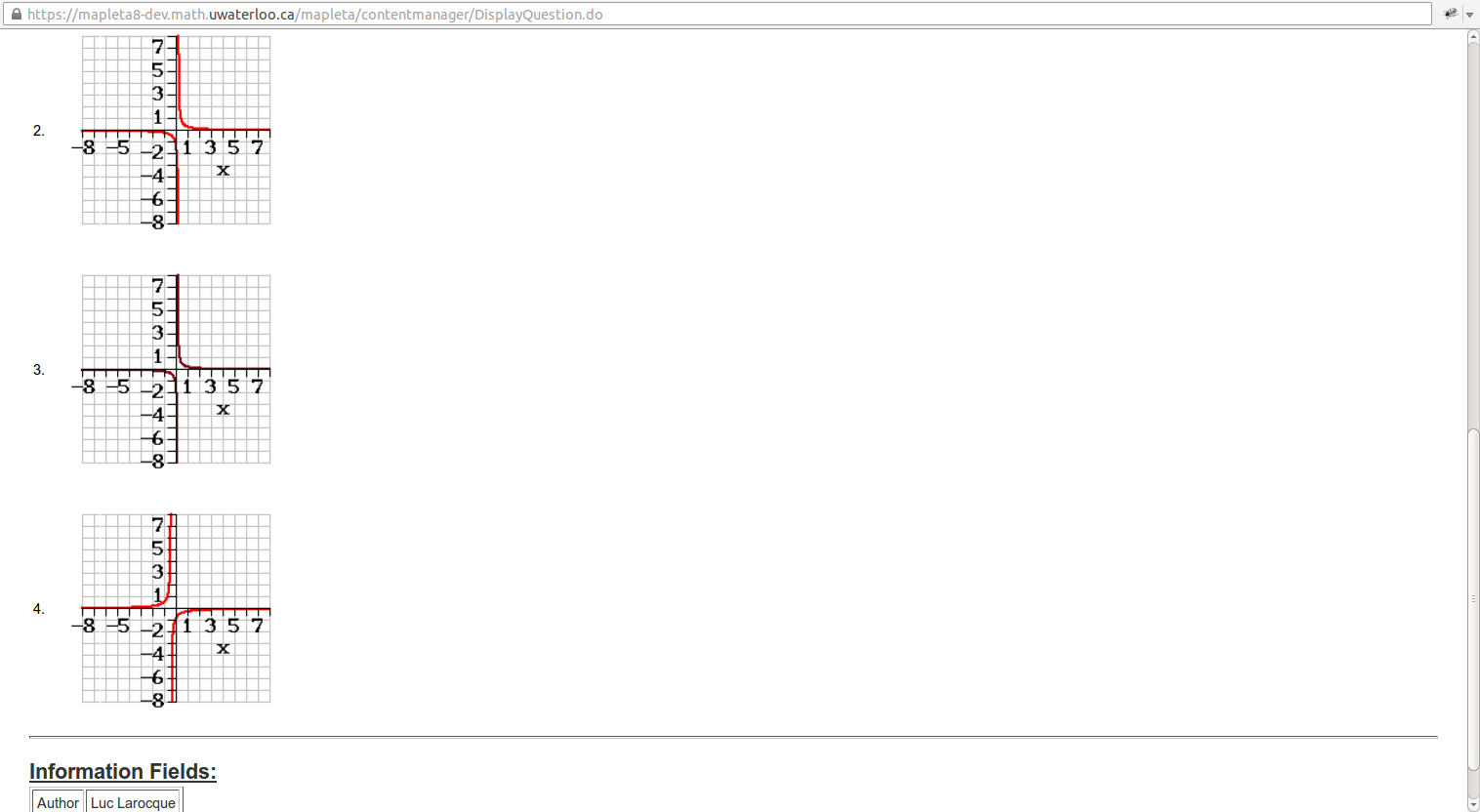
- Some of the plot lines are light-red and some dark red in the linear
and reciprocal functions. The line colour shouldn't be mistaken as a clue.
- Images of plots need to be made with higher resolution and then
displayed with a smaller width online, otherwise plots look jagged.
- I should check the mapleta matching-question type to see
if both the question plots and answer plots are possible in a horizontal line.
Have to scroll a long way down the page with the answer plots now.
- The answer (quoted below) has an extra '(' or a missing ')' in the first line.
- In the explanation, instead of remembering slopes and quadrants of the plot
(see the question answer quoted below), is it simpler (or not) to remember
something like the following?
Where the original linear function is 0 (the x-intercept or root of
the function), its reciprocal function will have a vertical asymptote
line and a plot on either side of this line.
The linear and reciprocal functions will have the same sign for y on the
left side of the root and the left side of the asymptote line.
Similarly, the linear and reciprocal functions will have the same sign for
y on the right side of the root and the right side of the asymptote line.
Question answer:
Comment:
When trying to match the graphs (for the case of linear polynomials: f(x) = mx + b
^ extra ( or missing )
Determine the sign of the slope of the linear function - is it a positive or a
negative slope?
The reciprocal of a linear function with POSITIVE slope will have branches (the
two distinct parts of the graph) on the bottom left and top right portions of
the graph.
The reciprocal of a linear function with NEGATIVE slope will have branches on
the bottom right and top left portions of the graph.
Look at the x-intercepts of the function; these will be the x-values at which
the reciprocal functions will have asymptotes.
Group 4.1 Q.02 Matching Reciprocal functions - Quadratic functions
Comments:
- All the function plot lines are now dark red.
- The numbers on the grid lines could be a bit smaller and clearer.
- The answer (quoted below) has an extra '(' or a missing ')' in the first line.
- I think the answer is a bit incomplete.
- It talks about 2 of the 3 cases: 0, 1 intercept but has only a diagram for
2 intercepts.
- And, the 0 intercept case doesn't mention sign.
- And, this quadratic function answer uses the intercept idea but the linear
function answer in Q1 above does not, when it could use the same idea.
Question answer:
Comment:
When matching the graphs (for the case of quadratic polynomials f(x) = ax^2 + bx +c:
^ extra ( or missing )
Look at the x-intercepts of the function; these will be the x-values at which
the reciprocal functions will have asymptotes. For example,
See maple image 1 below: 2 intercepts.
If there is only one x-intercept, there will be two symmetric branches
(distinct parts) to the graph -- they will open upward if the original parabola
opened up, and downward if the original parabola opened downward. For example,
See maple image 2 below: 1 intercept.
If there are no x-intercepts, the reciprocal function will appear as a "bump"
along a horizontal asymptote. For example,
See maple image 3 below: 0 intercept.
Image 1: 2 intercepts:

Image 2: 1 intercept:
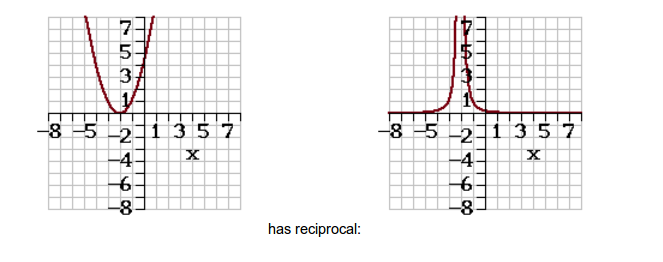
Image 3: 0 intercepts:
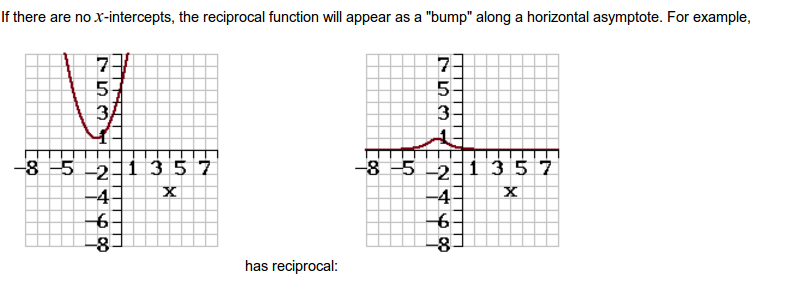
Group 4.1 Q.03 Identify function from graph of reciprocal
- Some of the plot lines are light-red and some dark red in graphs of 1/f(x).
- In the general part of the answer (quoted below), the fourth plot labelled
"4. f(x) is linear" isn't a reciprocal of a linear function.
It is a reciprocal of a non-linear (rational) function
instead, f(x) = x/(2x+1) --> 1/f(x) = 2+1/x.
The horizontal asymptote is above the x-axis.
See Image 1 below.
- The plots of the reciprocals in Image 2 below have not enough scale
to show the differences between 2 possible answers for 1/f(x).
One f(x) is (x+2)(-x+2) = -x^2 + 4 and the
other f(x) is (-2x+4)(x+2) = -2x^2 + 8.
Both have the same x-intercepts but one is a bit taller than the other
with y-intercepts at 8 vs 4, which makes the reciprocal plots look
identical. Yet one answer is marked wrong.
See Image 2 below.
- In the quoted question answer below, are two suggestions for
inserting the text "in the function y=1/f(x)" and "f(x)", to
keep clear which function is being discussed.
In general, the comment section has a lots of cases which is nice to look at
and good to include, but likely won't be memorized. So the general
answer helps only a little.
Maybe also add a description with a focus on the parts of the x-axis where
f(x) is +ve and -ve and 0.
And then look for the same signs in the reciprocal plot 1/f(x) and visa versa.
Image 1: Last plot of "4. f(x) is linear" but f(x) isn't linear:
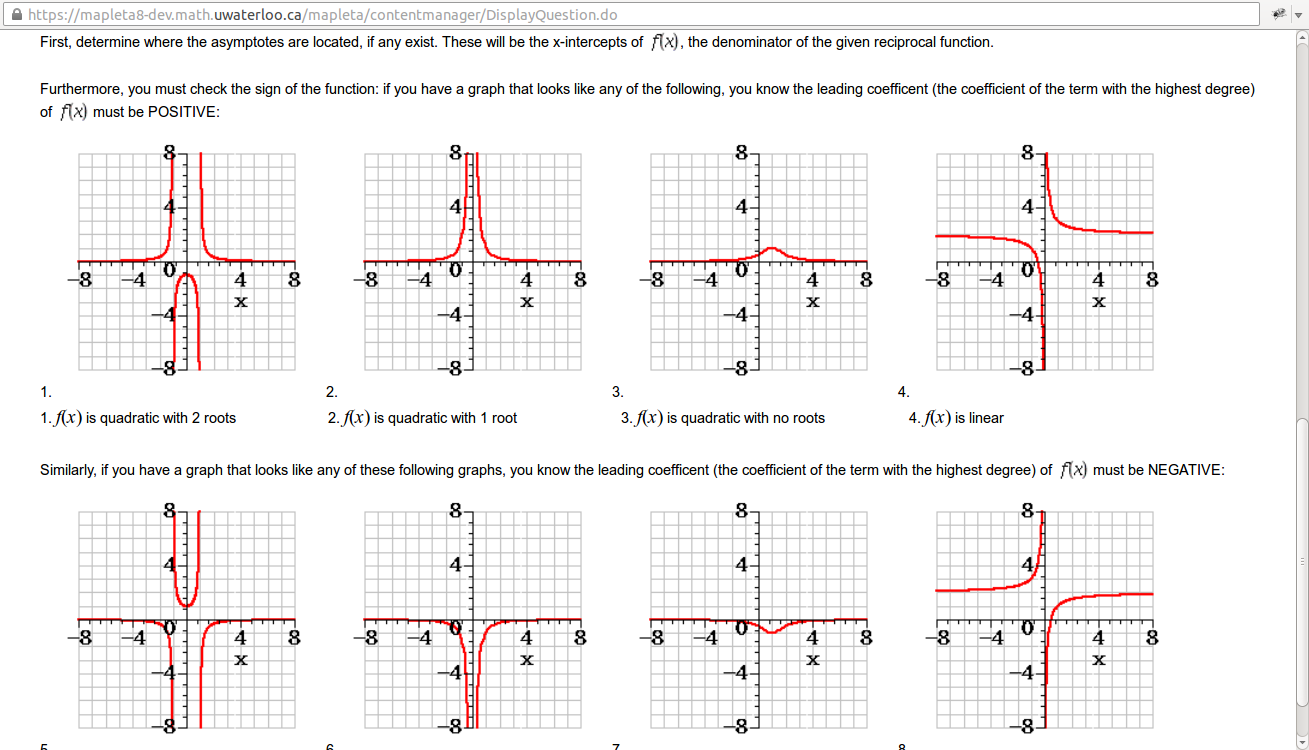
Image 2: 1 intercept.
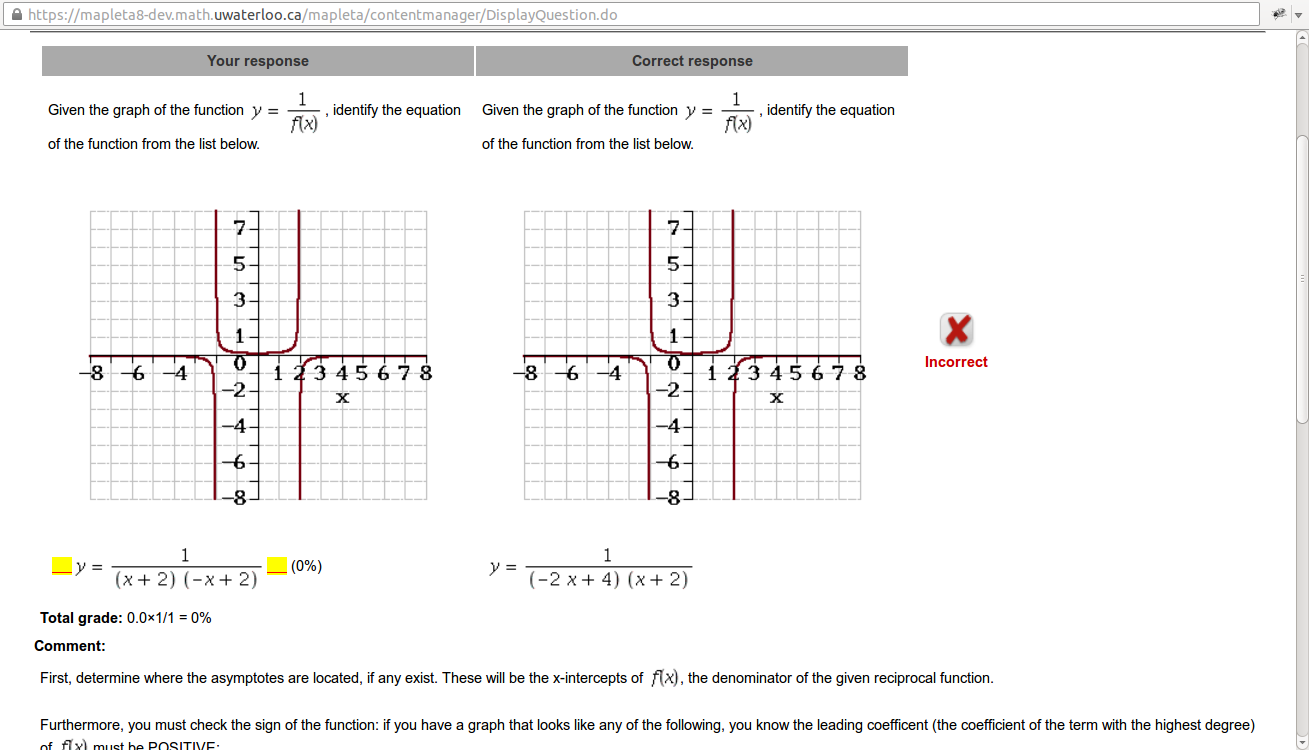
Question answer:
Comment:
First, determine where the asymptotes are located, if any exist.
^ in function y=1/f(x)
These will be the x-intercepts of f(x), the denominator of the
given reciprocal function.
Furthermore, you must check the sign of the function: ...
^ f(x)
Contact
Paul Kates
Mathematics Faculty CTE Liaison
pkates@uwaterloo.ca, x37047
Last modification date: Fri 11 Jul 2014 09:34:32 AM EDT
 Second image with 2 almost the same reciprocal functions
image (in answers 2 and 3):
Second image with 2 almost the same reciprocal functions
image (in answers 2 and 3):





